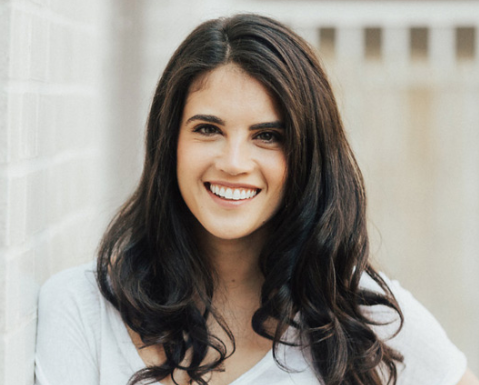How to Stop Eating When You’re Full
In order to stop eating when you’re full, follow these 3 guidelines in order to cultivate trust with your body. Most importantly, it’s hard to stop eating when you’re full if you don’t eat when you’re hungry. Get in touch with your physical signs of hunger first.

What does it mean to stop eating when you’re full? For me, it’s a comfortable feeling of satiation. It’s feeling energized, without being weighed down. It’s trusting my body and having confidence that I can feed my body what it needs, when it needs it, no matter the time of day.
I personally know how good it feels to find comfortable fullness. I used to overeat all of the time. Like many of the clients that I work with, I had a scarcity mindset when it came to food. Because I would restrict myself I often over-ate before the restriction would set in. I didn’t trust my body.
As such, one of the first things I work on in my private practice is cultivating body trust. As a registered dietitian who helps women improve their relationship with food and make feel good food choices, I define trusting your body as following internal cues to guide your choices, not external cues.
Amongst the strongest internal cues to follow are your hunger and fullness cues. Hunger and fullness can be thought of as a continuum. On a scale of 1 through 10, one would be extreme hunger, whereas 10 would be extreme fullness. For optimal satisfaction, blood sugar balance, and metabolism support, we’d like to keep your hunger and fullness between a 3 to 7 (ish). Of course it’s 100% normal to eat outside of this range, but this is a good target range to aim for.
If you’re just starting to learn how to trust your body, learning your physical signs of hunger is a great starting point. This blog can help. As you’ll learn, it’s essential to eat when you’re hungry and not wait until you get over-hungry in order to also honor your fullness.
If you’re so accustomed to undereating or waiting to eat until you’re so hungry it’s difficult to honor your fullness. No wonder you don’t know what comfortable fullness looks like and how to stop eating when you feel full.
Physical Signs of Fullness
Just as there are physical signs of hunger, there are also physical signs of fullness to be on the lookout for. Through my work with clients I have found 5 key signs of physical fullness…
Here are 5 key signs of physical fullness:
- Calm stomach
- Lack of emptiness
- Feeling energized
- Lack of desire for food
- Comfortable satiation
As you may notice, some of these physical signs of fullness are the opposite of the physical signs of hunger. You’re no longer feeling empty or thinking about food.
What’s the Difference Between Physical Fullness vs. Satisfaction?
However, there’s a difference between feeling physically full and satisfied.
When you’re physically full your stomach has filled up. It’s stretched just enough to send a signal to your brain that you are no longer hungry.
When you’re satisfied you stop thinking about food as much. You’re not longing for food anymore. You’ve eaten what you’re actually in the mood for so thoughts of food don’t linger.
It’s important to be both physically full AND satisfied from your meals. In fact, it’s one of the ways to stop eating when you’re full.
Here are 3 guidelines to follow to stop eating when you’re full:
1. Start eating when you’re hungry, not over-hungry
One of the most important ways to stop eating when you’re full is to start eating when you’re hungry. By honoring your hunger you’ll better be able to trust your body that you can start and stop eating when you want.
Here’s why… If you wait until you’re over-hungry your blood sugar drops below desirable levels. This leads to a physiological reaction for you to crave sugar to bring your blood sugar levels back up to a desirable level. That’s why when you get over-hungry you typically crave quick carbs, like white, highly processed, sugary foods.
This is also why you tend to over-eat when you start a meal over-hungry.
The fix: Do not delay hunger!! Honor your hunger and eat when you feel signs of hunger instead of pushing it off until later or after another meeting. You know it’s not a good idea to hold in your pee, well the same is true of your hunger!
2. Allow yourself to eat the foods you love
If you’re not satisfied AKA you don’t eat the foods you love, it’s much easier to keep eating to search for satisfaction. Instead, if you eat the foods you love consistently it’s easier to stop eating when you feel full.
Satisfaction is often a missing piece of the puzzle. You’ve probably heard before that it’s better to eat the “real deal” than to trick yourself with the fake stuff? Think about ice cream for example… sure, you could eat an entire pint of the fake stuff for the same calories as one scoop of real deal creamy ice cream… but is that satisfying to you? If yes, keep doing you! But if you’d rather have the real stuff to turn off your thoughts about food, well, I’m here for that!
The fix: Consider this permission to eat what’s most satisfying. Order the burger over the grilled chicken if that’s what you truly want. Then tune into your fullness and see how much easier it is to stop eating when you feel physically full because you are more satisfied.
It may not happen the first time, but it will happen if you practice over time.
3. Know that you can eat again when you’re hungry
I’m not sure which of these guidelines is most important (because they all carry a heavy weight), but truly internalizing and giving yourself permission to eat again when you feel hungry is key to stop eating when you feel full.
Think about it… if you know you have a fasted blood test in the morning and can’t eat after midnight, doesn’t that automatically make you think you need to eat more the night before? I know it does for me and many of my clients. Whenever we foresee scarcity we want to eat more in the moment. It’s called the Last Supper Effect.
The same is true when you see yourself going on a diet. You eat all the things you “can’t have” on the diet the day before. (And then usually feel sick!)
It’s also why I find intermittent fasting to be difficult for individuals with a history of dieting. If you know you’re fasting in the morning or starting at 7pm, you’ll often eat more ahead of time, typically past your comfortable point of fullness.
The fix: Begin to internalize that you can eat when you’re hungry. Whether it’s one hour after your last meal or three hours later. The clock doesn’t know when you’re hungry, you do. The more often you consistently give yourself permission to eat when you’re hungry, the easier it is to stop eating when you feel full.
Do these 3 guidelines help you stop eating when you’re full, let me know?
There are three guidelines to follow in order to stop eating when you feel full. It takes consistency and practice in order to reap the benefits of these guiding principles, but over time you’ll learn how to stop eating when you’re full so you can feel comfortable, energized, and live your best feel good life!
XO


 Hi there!
Thanks for stopping by! I'm Chelsey, an online Registered Dietitian, recipe developer, budding photographer, and coffee addict! My mission is to help you feel good through food by answering the question "What should I eat?" Let's make nutrition approachable!
I hope you enjoy my personal collection of simple, healthy, food allergy friendly and nutritiously delicious recipes, plus tips and tons of tricks that will help YOU live a nutritionally-balanced life! I look forward to getting to know you better...
Hi there!
Thanks for stopping by! I'm Chelsey, an online Registered Dietitian, recipe developer, budding photographer, and coffee addict! My mission is to help you feel good through food by answering the question "What should I eat?" Let's make nutrition approachable!
I hope you enjoy my personal collection of simple, healthy, food allergy friendly and nutritiously delicious recipes, plus tips and tons of tricks that will help YOU live a nutritionally-balanced life! I look forward to getting to know you better...







